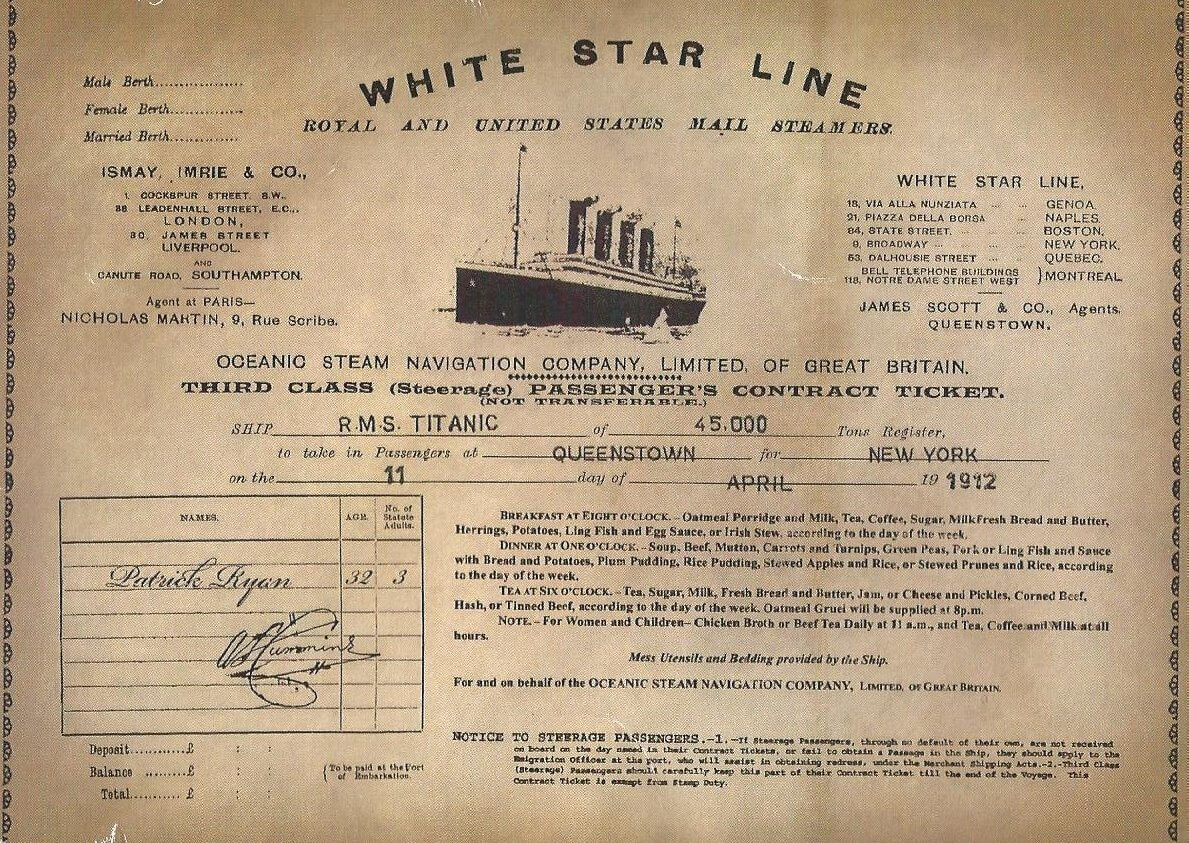Looking back at history, the sinking of the Titanic is one of the most significant maritime disasters ever. The Titanic was a luxurious ocean liner that was said to be unsinkable, but it sank on its maiden voyage in 1912 after hitting an iceberg. The disaster claimed the lives of over 1,500 people, making it one of the deadliest maritime disasters in history. The Titanic was carrying passengers from all walks of life, from the wealthiest people in the world to the poorest immigrants.
One of the most interesting things about the Titanic is the cost of tickets for the different classes of passengers. The Titanic had three classes of passengers: first, second, and third class. The cost of a ticket varied greatly depending on the class, with first-class tickets being the most expensive. The cost of a ticket was also affected by the type of accommodation that a passenger chose. For example, first-class passengers could choose between a first-class berth or a private suite, with the latter being significantly more expensive.
Ticket Classes and Costs
First-Class Tickets

First-class passengers on the Titanic were the wealthiest and most elite travelers of the time. They had access to the most luxurious accommodations, including private suites and state rooms, a grand staircase, a smoking room, a reading and writing room, and a grand dining room. The richest man on the Titanic was John Jacob Astor IV (an American businessman and real estate developer), and he bought a first class ticket for £512 (equivalent to £62,000 or $787,64 USD today).
According to sources, first-class ticket prices ranged from £30 to £870, depending on whether passengers chose a first-class berth or a private suite. Adjusted for inflation, this equates to between £3,651 ($4,638 USD) and £105,883 ($134,513 USD) in today’s money.
Second-Class Tickets
Second-class passengers on the Titanic were typically middle-class travelers who wanted a balance of comfort and elegance without the high price tag of first-class. They had access to amenities such as a library, a smoking room, a dining saloon, and comfortable cabins.
The cost of a second-class ticket on the Titanic was reportedly $60 (equivalent to $1,834 today). This ticket class didn’t offer first-class luxury, but it still provided passengers with comfortable accommodations, a dining room, and lounges.
Third-Class Tickets
Third-class passengers on the Titanic were mostly immigrants and working-class individuals seeking a better life in America. They had access to basic amenities such as communal bathrooms, a dining hall, and open bunk beds.
The cost of a third-class ticket on the Titanic was reportedly £7 (equivalent to £849 or $1,078 today). This ticket price was considered affordable for many skilled working men at the time, as it was nearly 7% of their yearly salary.
The ticket classes and costs on the Titanic varied greatly, depending on the level of luxury and comfort that passengers desired. While first-class passengers had access to the most luxurious accommodations, second-class passengers enjoyed a balance of comfort and elegance, and third-class passengers had access to affordable tickets that provided basic amenities.
Onboard Amenities and Accommodations
As a luxurious liner of her time, the RMS Titanic offered a wide range of onboard facilities and amenities to cater to the needs of her passengers. The ship was built with four decks, including a lower deck, middle deck, upper deck, and boat deck. The Titanic was enormous, with a length of 882 feet and a passenger capacity of over 2,200.
First-Class Amenities
First-class passengers enjoyed the most luxurious accommodations on board the Titanic. The ship’s first-class suites were the finest at sea, offering the ultimate in luxury. The most expensive first-class suite on board came with a price tag of £512 in 1912, which, adjusted for inflation, is a staggering £74,821 in today’s money.
The ship’s first-class dining room was a masterpiece of Edwardian elegance, with a capacity of 554 passengers. The room was adorned with exquisite wood paneling, ornate chandeliers, and plush furnishings. First-class passengers also had access to private cabins, a Turkish bath, a gym, a squash court, and a swimming pool.
Second-Class Facilities
Second-class accommodations were also quite impressive, with spacious cabins and outdoor deck space. The ship’s second-class dining room could seat up to 392 passengers and was located on the middle deck. Second-class passengers had access to communal rooms and a library, but they did not have access to the luxurious amenities available to first-class passengers.
Third-Class Living Conditions
Third-class accommodations were basic and functional, with communal rooms and shared bathrooms. The ship’s third-class dining room could seat up to 473 passengers and was located on the lower deck. Third-class passengers did not have access to private promenade decks or a la carte restaurants, but they did have access to men-only smoking rooms.
In conclusion, the RMS Titanic was a luxurious ship that offered a range of amenities and accommodations to cater to the needs of her passengers. The ship’s first-class suites and dining room were the finest at sea, while second-class accommodations were also quite impressive. Third-class accommodations were basic but functional, with communal rooms and shared bathrooms.
The Titanic’s Historical Context
The Titanic was a passenger cruise ship that was built by the White Star Line. It was one of the largest and most luxurious ships of its time, with a maximum passenger capacity of 3,547. The construction cost of the Titanic was around $7.5 million, which would be equivalent to over $200 million today.
Maiden Voyage and Sinking
The Titanic’s maiden voyage began on April 10, 1912, from Southampton, England, and was scheduled to arrive in New York City on April 17. However, disaster struck on April 14, when the ship hit an iceberg and sank in the North Atlantic Ocean. The sinking of the Titanic is considered one of the deadliest maritime disasters in history, with over 1,500 passengers and crew losing their lives.
Economic and Social Impact
The sinking of the Titanic had a significant economic and social impact. The disaster led to changes in maritime safety regulations, including the requirement for ships to carry enough lifeboats for all passengers and crew. The sinking also had a profound effect on the families of the passengers and crew who lost their lives.
The story of the Titanic has captured the imagination of people around the world and has been the subject of numerous books, movies, and documentaries. Historians continue to study the Titanic and its legacy, including the social and economic factors that led to the disaster.
Related: How Cold Was the Water When the Titanic Sank?
Frequently Asked Questions
How much was a ticket on the Titanic?
The cost of a ticket on the Titanic varied depending on the class of accommodation. A third-class ticket cost 7 pounds, while a first-class suite cost 870 pounds. In today’s money, that would be equivalent to between £3,651 and £105,883.
How many lifeboats were on the Titanic?
The Titanic was required to carry enough lifeboats for all passengers and crew, but it only had enough for about half of them. This was due to outdated regulations that did not take into account the size of modern ships.
Was the Titanic the largest ship of its time?
At the time of its launch, the Titanic was one of the largest ships in the world, but it was not the largest. Its sister ship, the RMS Britannic, was larger, but it never entered commercial service due to the outbreak of World War I.
How much did the crew of the Titanic earn?
The wages of the crew of the Titanic varied depending on their position and experience. For example, a steward earned about £3 per month, while a chief engineer earned about £1,000 per year.

